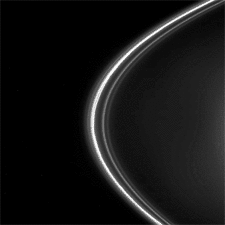Watching the birth and death of moonlets in Saturn's F ring

Written by
Emily Lakdawalla
July 22, 2010
The Saturn system is always in motion, always changing. Saturn itself is a gas giant, with swirling storms, and like the other gas giants it has a host of moons flying around, perturbing each other's motions. And then there's the rings. From a distance, they seem like a solid disk, and their overall shape and appearance doesn't really change with time -- there's the semitransparent A ring and the solid B ring separated by the Cassini division, visible from smallish telescopes.
Up close, though, the rings are in a constant state of change, because after all, they're not a solid, flat disk; they're made of uncountable small particles, ranging in size from dust up to tens, hundreds of meters in size, even a few that are a couple of kilometers across, which people usually regard as moonlets, although they're as much a part of the rings as any of the smaller particles.
One of the most dynamic parts of the rings is the F ring. The F ring was only discovered in 1979, when Pioneer 11 flew past. Owing to their exquisite sensitivity, the Cassini cameras yield pictures of the F ring pretty much any time they point at the rings. The F ring was particularly easy to spot near Saturn's equinox last year. As the Sun got closer and closer to passing through the ring plane, the flatter A and B rings got darker and darker, but the F ring -- which is more extended vertically than the A and B rings -- scattered the sunlight passing through it the same way it always did. Here's a view from last year, just a couple of months before the equinox, where you can see rings C (dark band, upper left corner), B (brightest broad, flat band), Cassini division (dark skinny band), A (dimmer broad, flat band, with a skinny gap, the Keeler gap, near its outer edge), and F (the brilliant thin line on the outer edge).

Viewed up close, it's immediately obvious that the F ring isn't just one skinny thing. It has multiple strands, and curious patterns. The image below was taken just after Cassini's first close pass by Saturn to enter orbit, on July 1, 2004; you can see two very bright ropes, a dimmer one, and some funny dark gouges crossing them all. And, at the upper left side of the F ring, you can see a potato-shaped moon, Prometheus. I'm sure this first view of the F ring from Cassini's cameras was thrilling for ring scientists -- there is much work to be done here to understand what's creating all that complex structure!

Immediately Cassini got down to the business of capturing long "movies" of the motions of Prometheus, Pandora, and the rings.

You can see interesting shapes in the F ring here, but all of the motion that you see is really just orbital motion; the features in the rings are, for the period of time that Cassini was observing them, pretty much static. To see how Prometheus actually interacts with the rings, Cassini needs to track Prometheus during its orbit. It takes 14.7 hours for Prometheus to complete one orbit around Saturn. When Cassini arrived, one Promethean orbit stayed pretty much within the gap separating the F and B rings. But the eccentricity (the elliptical-ness) of Prometheus' orbit changes over time; sometimes the orbit is more circular, and sometimes its more elliptical. When the orbit is more elliptical, Prometheus actually cuts into the F ring once each orbit, as it does in this animation.
Prometheus' interaction with the F ring This movie sequence represents almost one complete orbit of Saturn by Prometheus, the inner shepherd of the F ring. Both the F ring and Prometheus have slightly elliptical orbits, so, once each orbit, Prometheus wanders in to the dusty lanes of the F ring. As it moves back toward Saturn, Prometheus drags a streamer of dusty material behind it. Because Prometheus is closer to Saturn than the F ring, it orbits slightly faster, so the streamer lags behind Prometheus in its orbit. On the next pass around Saturn, Prometheus will intersect the F ring at a position 3.2 degrees of longitude ahead of this streamer, creating a new streamer. Over time, the streamers disappear. Cassini has seen as many as 15 streamers behind Prometheus in its orbit. The 72 images for this animation were taken 10.5 minutes apart over 23 and 24 November 2006. They have been reprojected to straighten out the F ring, showing the actual radial distance between Prometheus and the ring. The dark frames represent the period during which Prometheus and the F ring are eclipsed by Saturn's shadow.Video: NASA / JPL-Caltech / Space Science Institute
To get a sense of how the interaction between Prometheus and the F ring works, Cassini's scientists have done repeated F ring surveys. Here's one example of a little piece of such a survey, 10 high-resolution photos of the F ring captured over a period of about 80 minutes, beginning with Prometheus and scanning along the ring to cover 28 degrees of longitude.

Clearly there's a lot of structure in the F ring, but it's hard to tell what that structure is because it has been sheared out: particles that are closer to Saturn move faster in their orbits than particles that are farther from Saturn. So, to see what those structures are, the scientists "reproject" the images, taking the bend out of the rings, and then compress them longitudinally by a factor of 33. This is akin to making a time-lapse video, speeding up a slow natural phenomenon to make it easier to see how slow events unfold over time.

This is just one of what must be dozens, even hundreds of observations of the F ring's structure that Cassini has conducted over its six-plus years at Saturn. Each time, at each longitude, it looks slightly different; the science team has composed and examined similar mosaics for all those other observations.
Now that they've done all that work, what can we see? For the answer to that question, it's time to turn to a new scientific paper: "Direct evidence for gravitational instability and moonlet formation in Saturn's rings," just published in Astrophysical Journal Letters by Kevin Buerle, Carl Murray, and some other coauthors. The first authorship by Buerle is honorary; a programmer and key member of the Cassini team at Queen Mary University of London, died tragically in a freak hot-air balloon accident in Turkey a year ago. The kinds of programs Buerle wrote were simulations of how Prometheus' periodic foray into the F ring would gravitationally influence the particles within it. Here's an example of one of those simulations.
This computer-generated simulation depicts a 10-degree portion of the F ring (out of the 360-degree sweep of the full F ring). Prometheus moves from left to right just below the field of view. In the full version, the moon's effects on the ring are shown as they would occur over a total span of 72 days.
The abridged movie, "Dance of Particles in Saturn's F Ring," starts by showing the segment over an eight-day period just as Prometheus first passes by. It then jumps 60 days. We follow Prometheus's return for another four days as the moon interacts with this section of the ring again. This version of the movie also shows a sequence of images of the F ring, Prometheus and the moon Pandora, obtained by Cassini's cameras.
There are two main things going on as Prometheus wanders into the F ring. There are direct collisions between Prometheus and ring particles, and once the rings particles are disturbed, collisions among ring particles. And there are gravitational effects too; although Prometheus is pretty tiny, its close approaches do exert gravitational effects. Gravity tends to bunch things up; collisions tend to spread them apart. Which dominates?
The paper states that
At the closest approach during each [Prometheus] orbital period [of 14.7 hours], the gravitational effect of the satellite significantly perturbs an ~1° segment of the ring, and the streamer-channel pattern is repeated every 3.27°. Each passage triggers the formations of objects [described elsewhere as "gravitationally coherent clumps"] at the channel edges, and these now evolve with respect to the core of the F ring.
Then, every 67.6 days, Prometheus returns. When it returns, the team observed, it doesn't necessarily disperse the clumps that formed the last time it passed. In other words, the clumps that form in the F ring can survive numerous passages by Prometheus.
What should these clumps be called? Are they more moons of Saturn? They address that question in their conclusions.
The observational evidence suggests that, at least initially, these objects are formed by Prometheus and can be considered as coherent, enhanced density clumps which are still an integral part of the perturbed core, rather than fully formed moonlets.
Finally, we get to the part of the paper that addresses why it's being published in the Astrophysical Journal rather than something like Icarus or the Journal of Geophysical Research:
The process by which Prometheus triggers local condensations in Saturn's F ring has direct applicability to the more general problem of accretion in systems such as a protoplanetary disk being perturbed by a nascent protoplanet, where the embedded gas giant perturbs a marginally stable gas disk....The sustained creation and destruction of these collapsing objects reveals the F ring as a natural laboratory for studying the processes that facilitate and frustrate such rapid growth.
It's funny how sometimes -- as with the Io study I discussed on Tuesday -- our study of space brings us back to Earth; and at other times, like in this research, our study of a planet in our backyard can teach us about stars and planets beyond our own solar system and back (and forward) in time.

Breakthrough research starts with YOU!
Your support will empower the next round of STEP grant winners. Make your gift today to fund tomorrow's promising science and technology projects.
Donate

 Explore Worlds
Explore Worlds Find Life
Find Life Defend Earth
Defend Earth

